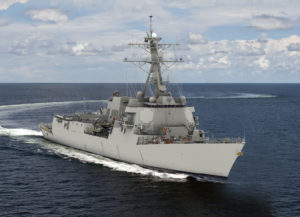A Navy official said the service is pushing back acquiring the future Large Surface Combatant (LSC) again to the late 2020s.
Officials had previously said they hoped to have the LSC on contract by as early as 2023, but now Director of Surface Warfare (N96) Rear Adm. Gene Black said he think the Navy will not buy a vessel until the late 2020s as it moves in a more measured pace on technology development.

“I think we will probably buy our first Large Surface Combatant in the late 2020s. After Flight III DDG reaches IOC, after more Flight III procurements, and after we’ve matured some new technologies to the right level,” Black said at the annual Surface Navy Association symposium Tuesday.
“We’re trying to do it in a very measured manner so that we minimize the risk as we go forward,” he continued.
Black reiterated the Navy’s desire for a new LSC to house large sensors; missiles; directed energy weapons; and the space, weight, power and cooling (SWaP-C) for future upgrades over a projected 30-plus year service life.
In October 2018, then-Rear Adm. Ron Boxall, Director of Surface Warfare, said Navy leadership wanted a new hull for LSC to take the DDG-51 Arleigh Burke-class Flight III capabilities with room for growth and had a goal to get it on contract by 2023-24 (Defense Daily, Oct. 29, 2018).
The Navy plans to build 10-12 Flight III DDG-51s before moving on to the future LSC as the next ship of the large combatant type. Flight I and II DDG-51s are set to start retiring in the late 2020s into the 2030s.
However, the service’s FY 2020 budget request from last March pushed back the first LSC procurement to the mid-2020s. That plan expected the Navy to conduct a preliminary design phase starting in FY 2020 leading to the release of a final Request For Proposals by FY 2024, with the first ship bought by 2025 at the earliest (Defense Daily, March 19, 2019).
The budget documents expected LSC to have a Vertical Launch System for larger missiles, extra capacity for embarked warfare commander and staff, improved radar signatures, support for 360-degree directed energy weapons coverage, and the DDG-51 Flight III’s more advanced SPY-6 Air and Missile Defense Radar.
Black explained while LSC will use the Aegis Baseline 10 combat system and the SPY-6 radar, which by then will have “been wrung out” so it will then take some risk in “probably the hull form, probably integrated power, and the integration of those pieces. So we’ve got some time and we’ve got some support to do that.”
Using integrated power looks likely, but the Navy first needs to conduct more land-based testing, Black said. The Navy is looking into directed energy on LSC as well but it is asking “what technology is going to give us the most capability, how am I going to have, for example, an energy magazine so that when I turn on directed energy it doesn’t take the entire electrical system down, how is that going to work?”
Black said the Navy is looking for a hull form that is in “the sweet spot in endurance, signature, cost to build, cost to operate, operate a big sensor, how much do I need for a bigger missile – we’re working all those pieces and parts, and we’ve got some time to do it.”
While it is not clear what the Navy may plan for between the end of DDG-51 Flight III procurements and LSC, some in Congress have started asking about that.
In a May hearing of the Senate Appropriations Defense Subcommittee, Sen. Susan Collins (R-Maine) asked why the Navy was moving forward with the new hull LSC by FY 2025 rather than requesting another multi-year contract for more DDG-51 Flight IIIs until the LSC is more developed. She cited the danger of lead ship challenges and delays in the past, particularly the Zumwalt-class, and how that could impact the industrial base.
Then-Secretary of the Navy Richard Spencer and then-Chief of Naval Operations Adm. John Richardson said they wanted to keep the industrial base in mind while also making sure the service gets the best value for the dollar. They claimed the service will use what it learned in using a proven hull design and early industry requirements discussions in the new guided-missile frigate, FFG(X) (Defense Daily, May 2, 2019).
This latest LSC acquisition pushback also comes after an October Congressional Budget Office’s (CBO) regular analysis of the Navy’s 30-year shipbuilding plan that argued the LSC may cost $67 billion more than the service was planning (Defense Daily, Oct. 10, 2019).
The Navy’s FY 2020 budget plan estimated the LSC at about $1.7 billion each, the price of the current DDG-51 Flight III, but CBO estimated it would cost closer to $2.8 billion each. CBO argued that based on official statements on what the service seeks in an LSC, the new design and larger hull size will cost significantly more than the Navy’s budget projections.
The Navy issued two Requests For Information (RFI) for the LSC last February as part of the requirements analysis process, seeking industry market research to support the ship’s requirements development. One RFI focused on shipbuilders, ship designs and ship and combat system integrators with the other focusing on system and equipment providers (Defense Daily, Feb. 26, 2019).